I had the pleasure of speaking at the 2nd International Meeting on Indigenous Women’s Health in Albuqueque last week. Flying there, I connected at LAX and flew east over the arid lands of California, Nevada, Arizona before we descended through cumulonimbus clouds into New Mexico. As we levelled out on final approach, with the airport in sight, the little jet suddenly accelerated and flew high up into the clouds again. We circled Albuquerque for about 45 minutes as the pilot explained that the airport was experiencing “microbursts” which prevented any landings. We had a lovely view of the amazing New Mexico terrain through the clouds as we whiled away our time. Eventually we zoomed off to land in Durango, Colorado where we sat on the tarmac until we had the “all clear” to return to Albuqueque to land. I have flown a lot over the years but his was a first – to see the airport but to be told that we were unable to land. Usually, when we can’t land in British Columbia it is because you can’t see the airport. And, I think these “micro-bursts” are what we call “rain” up here, although ours tends to come in “macro-bursts”.
Although it was a three hour delay, it was also an amazing opportunity to see the desert landscape from a perspective where it was clear how the forces of wind and water had shaped the land over millennia. It reminded me of the “rocks for jocks” geology course I had taken years ago as an undergrad at the University of Calgary and how we were taught that advances in geological science occurred quickly after air travel became common. It also makes me think that our reductionist approach to nutritional science would benefit from a perspective that looks more holistically at the contours of the problems we face. For example, when you look at the shape of the obesity epidemics that are sweeping the world, how can you conclude that we are on the right track with our prevention efforts which are based on the calories-in/calories-out paradigm? You can’t. I was at a meeting in New York a couple of months ago where I had a conversation with a Finnish colleague who was in the business of health promotion. They are proud of the success of North Karelia where cardiovascular disease risk was dramatically improved, apparently through a concerted health promotion effort using the conventional ideas of low-fat calorie restricted diets for weight loss, more fruits and vegetables, etc etc in the 1970s. They also promoted smoking cessation and there is evidence that other areas that didn’t embark on a similar campaign actually saw similar improvements, but, nevertheless, North Karelia is held up as a shining example of how the consensus approach to diet is the correct approach. How can you argue with those results, right? Well, the question I had for my colleague was, “If North Karelia showed us the simple solution to how these problems could be fixed over four decades ago, why hasn’t this approach been used to fix the problem everywhere else in the intervening years?”. Of course, she had no answer. I am told that there was a television documentary produced in Finland a couple of years ago which was basically an expose of the fallacies of the North Karelia story. Unfortunately, it is not available in english as far as I know.
My ordeal in getting to Albuqueque was worth it in the end, though. My “Big Fat Diet” talk was well received and I was swarmed with people asking questions and seeking copies of my slides. I was asked to host a small round-table discussion later in the program, and, again there was enthusiastic interest in what a low-carb high-fat diet can offer to those who struggle with excess weight and the metabolic problems associated with insulin resistance. One of the questions I was asked there and that I get asked wherever I lecture is “what do you eat?”. It occurs to me that I should add some slides to my powerpoint presentation to provide the answer. I thought you might like to see some examples here. These are photos of a couple of typical dinners, a typical breakfast and my usual lunch. I have added a photo of a birthday cake I made for my son’s eleventh although it is not something we eat that often. I will add a photo of my low-carb organic chocolate pecan ice-cream the next time I made a batch.
In the meantime, feel free to share these photos with any naysayers you encounter who try to tell you that a low-carb diet is too boring and restrictive to sustain.
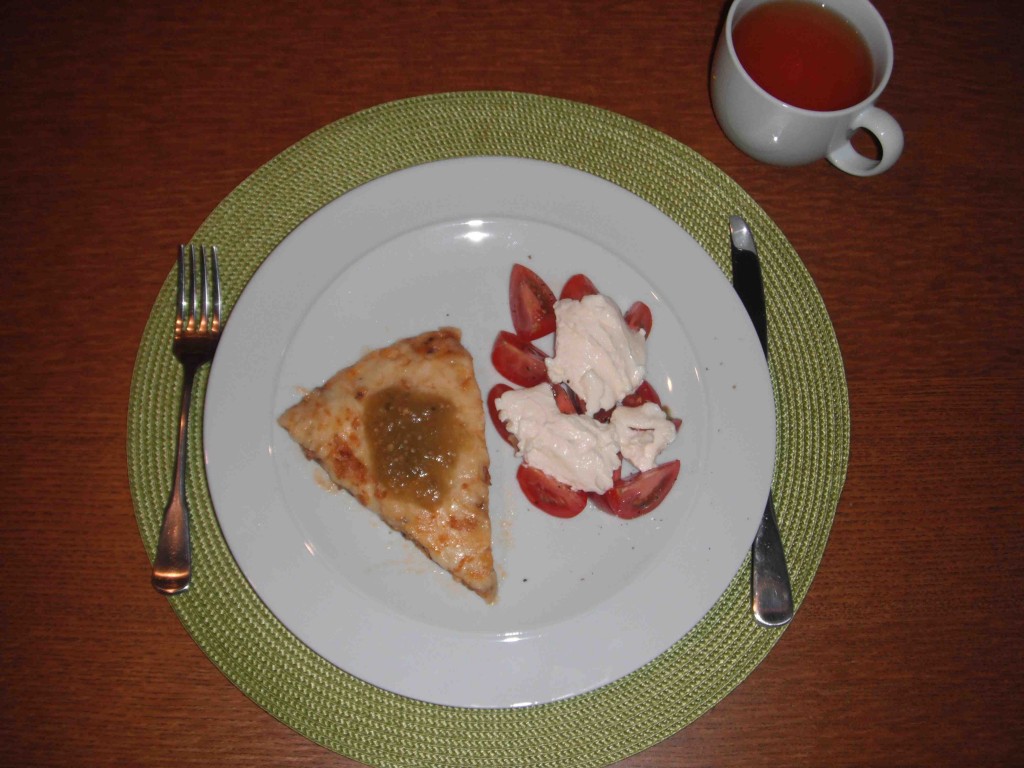
This is my usual breakfast these days. Frittata made with eggs, cream, bacon, mushrooms, onion, chipotle peppers and cheese, topped with some green salsa and accompanied by fresh tomato with mayo and a cup of hot, black tea. Yum!
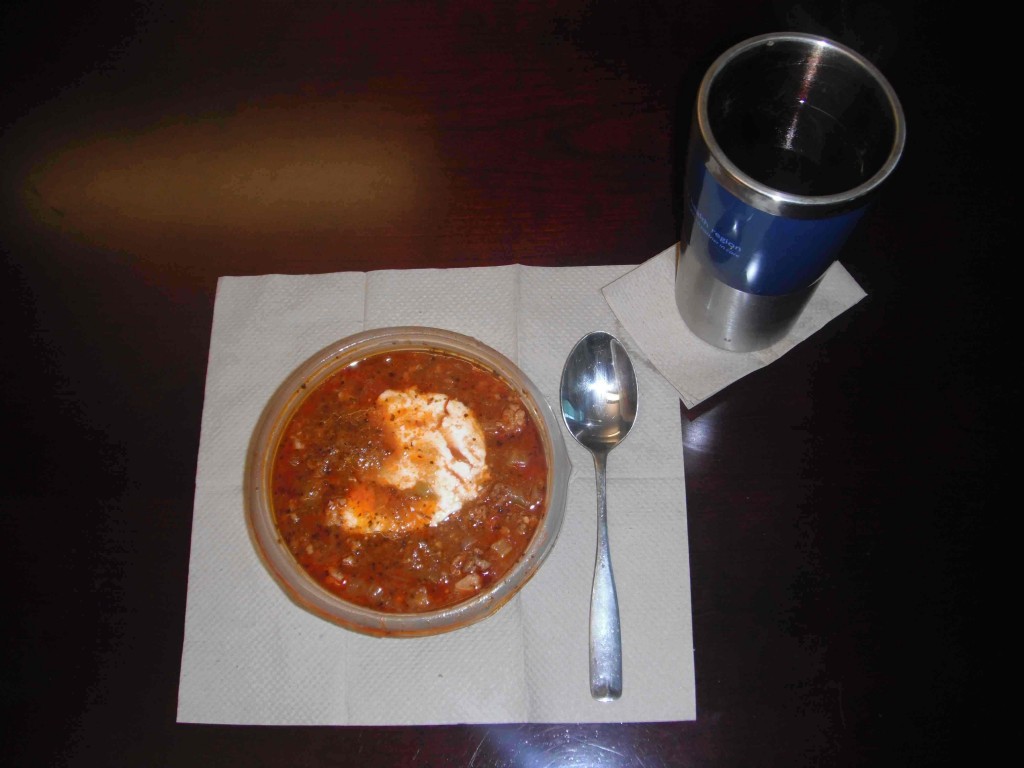
Lunch at my desk. This is my beanless chili. The recipe is adapted from one in "Everyday Paleo" by Sarah Fragoso. It is made with ground pork, ground beef, Italian sausage, Italian tomatoes, chicken stock, onions, celery, basil, oregano, cumin, chili powder, cayenne, salt and pepper. It is delicious served with a dollop of sour cream and some green salsa and accompanied by another cup of hot, black tea.
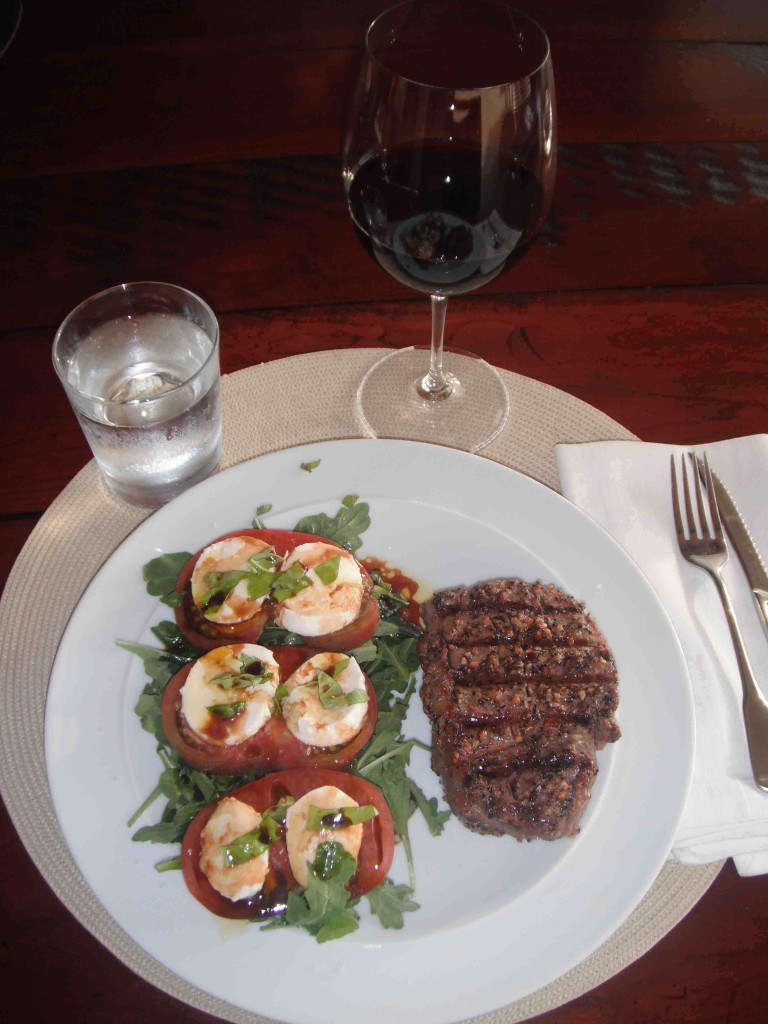
What would low-carb be without the occasional steak? This one was rubbed with olive oil and dusted with Montreal Steak Spice before being grilled. It is served with bocconcini and heirloom tomato on a bed of arugula, drizzled with olive oil and balsamic vinegar with some coarse sea salt and fresh basil. Note the glass of hearty red wine, a must when eating steak IMHO.
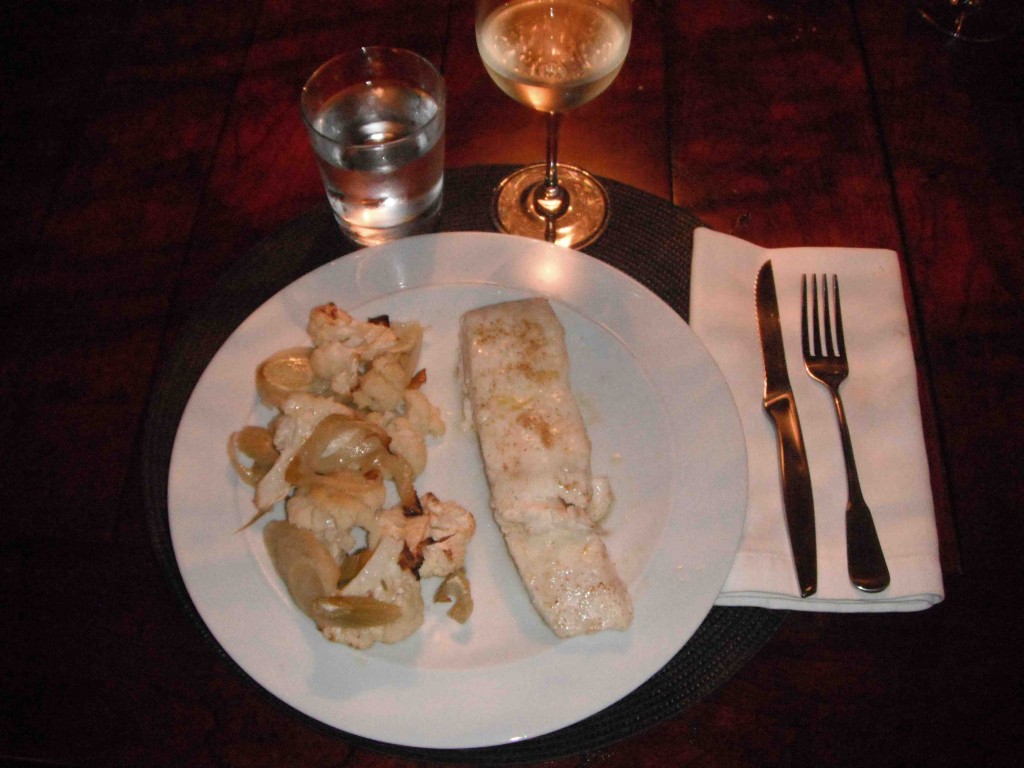
Halibut dinner. On a recent trip to Haida Gwaii, I was fortunate in being able to stock up on halibut. Here it has been rubbed with olive oil and dusted with a little garam masala and then baked in the oven. It is served with roasted cauliflower and anise that had been tossed with olive oil and coarse sea salt. Note that white wine goes with white meat and seafood but that it has more residual sugar than red wine. Having said that, I believe that one little glass is not going to upset the applecart, so to speak.
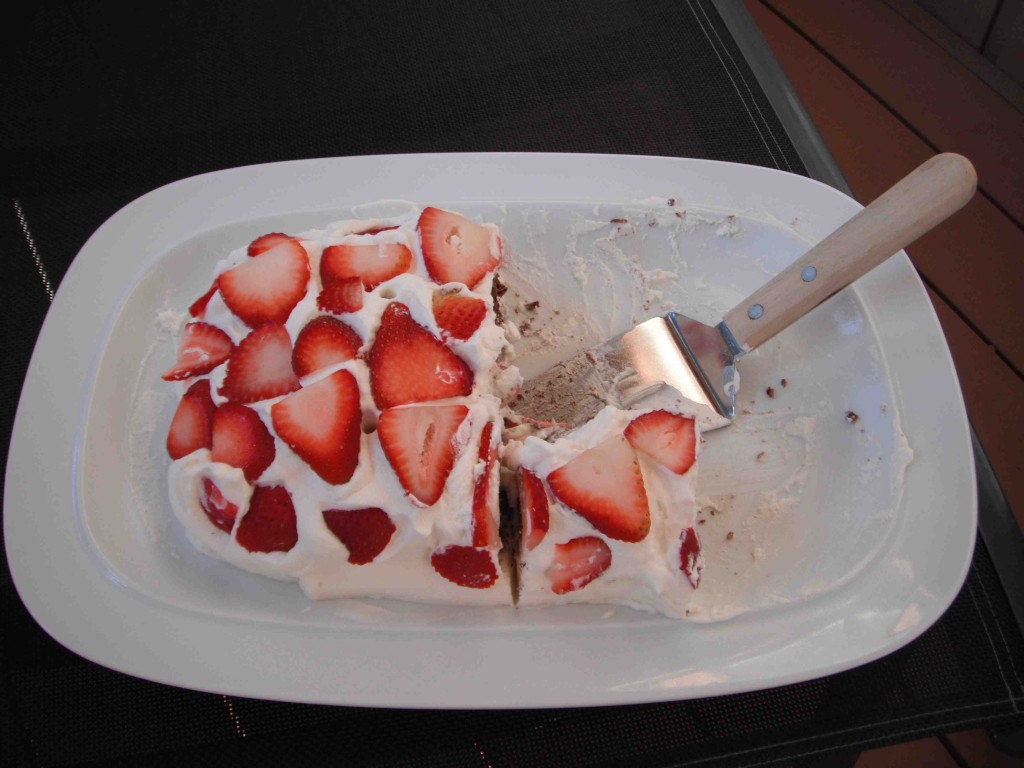
Low-carb birthday cake. Here is a chocolate birthday cake with whipped cream icing and fresh strawberries that I made for my son's eleventh birthday. The recipe is adapted from the one-minute chocolate cake recipe you can find on the recipe tab above. Enjoy!

Thanks for sharing, Dr. W.
You saw some of the best terrain in the U.S. – the great Southwest.
I lived east of the Missippi river for 12 years; can’t see myself going back.
-Steve
Dr Jay’s Reply:
I agree. There’s something about the western part of this continent. I lived in the east for a four year stretch and I was pining to go back to the west pretty much every day.
I’m quite sure you and your readers will find this interesting.
http://movies.netflix.com/Movie/Forks-Over-Knives/70185045
Tom
Dr Jay’s Reply:
For anyone contemplating seeing that film I would highly recommend reading Denise Minger’s review first (www.rawfoodsos.com). It may save you wasting 90 minutes of your life that you will never get back. On the other hand, after reading Denise’s excellent dissection of the fallacies and misrepresentations put forth in the movie, you may find it interesting to look at it as an exercise in understanding how skillful propaganda works. Kind of the same way you should study “Triumph of the Will”.
Hi Jay: It has been some time since I posted a comment. I just wanted to check in with you on what I believe is an emerging pet peeve of mine. I recently received in the mail something called the Native Food Guide, which I reviewed with anticipation, believing it might be useful in diabetes prevention. To my disappointment it appears to be nothing more than an indiginization of the Canada Food Plan. For example it includes rice, rice root, bannock and oatmeal as native foods. I find this surprising as they strike me as post-contact in origin. I have written to my First Nations community health reps in the hope that they may provide some insight into how to appropriately use this guide if that is possible.
I have a family history of diabetes and am making efforts to NOT end up with it. We are currently following Atkins and have added in some Carbs but have plateaued so we are returning to induction. I have lost the requisite initial 10% of my weight and found that blood pressure and c reactive protein, which was elevated, have come down somewhat.
We did a garden this year and are now in the midst of the harvest and preserving the bounty. As a demonstration of our commitment we decided to not plant potatoes this year and find generally not to have missed them. Though as we make a mean paella, and occasionally make it for company, we have also eliminated our version of fast food which is rice and fish.
I really appreciate your blog. It is a good guide to return to when in doubt about our food choices. On the bright side, we caught and smoked a pile of salmon this summer and also have a freezer full of organic chicken courtesy of a neighbour. The only challenge I deal with is use of eggs. My local doctor has recommended I restrict to three a week due to my borderline cholesterol. And this is a fall back food for me on Atkins. I figure I used up my entire egg allocation through to 2012 by June. I was encouraged by your frittata. Great photos. Cheers, Ardyth
Dr Jay’s Reply:
I envy you your ability to access and store what sounds like an excellent supply of good food for the winter. It sounds like you are on the right track with the diet, too. Staying on induction, for people who have started to develop insulin resistance, may be the only way to maintain a healthy weight and normal metabolic markers. If your doctor is worried about your cholesterol and is recommending you avoid eggs, there are a couple of things you may wish to consider. Firstly, the cholesterol in eggs, or any food, for that matter, has little impact on the cholesterol in your blood. Your body needs cholesterol and makes it in the liver to meet those needs. What you eat has very little to do wtih that. There was some research that suggested that diabetics should limit their intake of eggs. I didn’t find it convincing. It was an observational study, to begin with, which means you cannot imply causality. And it didn’t make sense in terms of mechanism. What would make a diabetic more susceptible to a problem from eating eggs that would not also occur with a non-diabetic? What is the difference between diabetics and non-diabetics? Higher blood sugars and perhaps higher insulin levels. Well, I have neither, nor should anyone else who sticks to an induction level of carbs. Anyway, I walk the talk, as you can see. My frittata is 1-1/2 eggs per slice and I eat a slice every day.
It’s good you are also looking at your c-reactive protein. The inflammatory status is important when looking at chronic disease. I take comfort in a very low CRP even with an LDL that is technically high. I believe that inflammation is the underlying problem with respect to chronic disease and that the role of cholesterol is secondary. Keep the carbs low to get that CRP down. Also, keep avoiding the high omega-6 oils which can promote inflammation. Olive oil is good, canola is ok in a pinch, but all the others should be avoided. And read labels, lots of pre-prepared food use these oils. Ditto fast food outlets and restaurants. Oolichan oil would be ideal if you have access to that.
My final word on eggs – it seems to me that they are the perfect food because there is everything in there you need to make a baby chicken.
As to the food guide issue, I think it represents a general effort to translate the Canada Food Guide into versions that work for different ethnicities, reflecting their particular ethnic foods. I have no problem with that, however, they do run into a little problem with Indigenous diets because, unlike the diets of the various immigrant groups, there was little in the way of starchy or sugary foods in the Indigenous diets (some exceptions where agriculture had started). This is why you see non-traditional foods represented there in the carbohydrate sections. From my perspective, I think the Indigenous diets were healthy by definition. If people stuck to their traditional diets, I don’t think we would be seeing the problems we have now with chronic disease. The Indigenous food guide doesn’t represent an Indigenous diet so much as it represents an Indigenous version of the Canada Food Guide. Although I am a big fan of the Indigenous diets, I also think that if people followed this food guide version, they would be much better off than they are eating what most people eat today. Small steps.
Bottom line, though, is that if you have developed insulin resistance, it doesn’t matter what was your traditional diet or your ethnic background, you should be on a carbohydrate restricted diet to manage your metabolic problems.
Great pictures of delicious looking meals! I find most people are very conservative in their ideas about food and meals, and I used to be as well. There were foods one ate for breakfast, and others for lunch and dinner; mainly culturally driven habits. My children thought it was very funny whenI told them that my mother considered spaghetti a “foriegn” food, which to her it was in as much as sushi was to me thirty years ago in rural northwestern U.S. How and what we ate was pretty consistent with mere variations. Now I don’t put food in such boxes, and eat whateve low carb, high fat food is handy. It’s very freeing to know I can eat whatever I feel like that’s healthy, like today I had a bison burger with blue cheese and eggs on top for breakfast.
Dr Jay’s Reply:
That sounds like a great idea for breakfast!
Here’s my favourite breakfast for busy days: I boil some seasonal veg which may be purple sprouting broccoli, asparagus, runner beans or currently brussels sprouts and chestnuts, fry a giant mushroom and some lamb’s liver in olive oil and grill (broil) some back bacon. OK I cheat a bit and have two oatcakes (5g carb each) but I need something to support the grass-fed butter.
After that I routinely don’t need to eat again for 8 – 9 hours, even if I spend the day walking with 10 kg of photographic gear or doing Extreme Gardening.
This completely freaks some people out because they are so fixated on Healthy Whole Grains, which aren’t, especially for breakfast. Even some diabetics can’t handle the concept of enjoying food which isn’t based on starch, but what’s not to like? It’s tasty as all get out and doesn’t disrupt my (or your) metabolism.
I wish I Iiked eggs but I have to wait until they grow up before enjoying them. Likewise I can only eat grapes when they have matured . . . into a bottle. Ah, such deprivation!
Dr Jay’s Reply:
Sounds like a great breakfast although I would have to avoid the oatcakes as my tolerance for carbs is quite low. When it comes to eggs, I use a type that is rich in omega-3. They are large and have dark yellow yolks. If I have to eat the regular types that are sold in the supermarkets, I find them quite pale and unappealing. I am with you on the grapes. I feel the same way about lactose, too.
I need enough carbs at breakfast to generate enough insulin to shut down my glucagon, which amounts to about 10 – 15g. I used to be limited to about 30g by evening but now can get away with 50 – 80g and sometimes more.
Not many doctors and hardly any dieticians seem aware of the diurnal difference in IR (or the fact that some people have the opposite effect where their carb tolerance actually *is* better in the morning, these are probably the only people who can tolerate high carb breakfasts though the Diabetic Diet of a bowl of porridge oats with a banana, toast with low fat spread and no-sugar-added marmalade and a glass of orange juice would probably defeat even them!)
Damn trick livers. I don’t get Dawn Phenomenon as such, but my liver used to lay in wait and dump far too much glucose if I overexerted myself in the morning. By afternoon it would withold the glucose when I needed it and I could easily hypo.
Using fats and ketones as my primary food source seems to have put a lid on it. Probably this has grossly reduced liver IR, or perhaps its the communication between pancreatic alpha and beta cells that doesn’t work right and has now been partially mended.
Yes I go for Real Food from the butcher, fish van and veg shops, much more flavour than the supermarket stuff and very likely more nutritious. Perversely I prefer skimmed milk, it’s a flavour thing. I only use it to whiten my coffee, my dairy otherwise is grass fed butter and Real Cheese which I can more than tolerate.
Dr Jay’s Reply:
In my quiet moments I daydream of a utopian future where the big funding agencies support studies to examine these effects of LCHF. Does long-term adherence, for instance, reverse hepatic IR? Can one restore tolerance to carbohydrates over time? Etc, etc etc. So far, just fantasy, unfortunately.
Anecdotally the answers are yes and yes – and there are a hell of a lot of anecdotes, even in the ADA’s own forums.
Using trigs/HDL as an indicator for IR, many people significantly improve their insulin resistance and carb tolerance, which can be demonstrated by improved postprandial BG
http://loraldiabetes.blogspot.com/2009/04/test-test-test.html
Over time and many forums I’ve seen a small number of individuals I actually trust when they claim to have largely reversed their diabetes. They are all severely overweight and predominantly male and the IR seems to be directly caused by the weight, not necessarily true for many/most other forms of “diabetes” where insulin production is also affected.
I think my breakfast carb tolerance has actually worsened slightly, but the evening numbers have improved by about 300%, and I’ve kept this up for some 6 – 7 years. I strongly suspect though that if I increased my carbs to these levels other than occasionally, the damage and symptoms would return.
When N=1 is in the thousands and agrees with evolution and historical dietary changes, there’s something desperately wrong with calling medicine “evidence based”